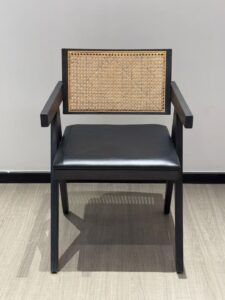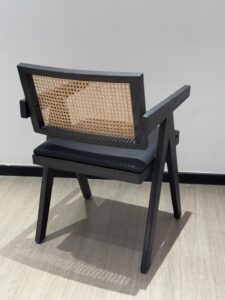I. The beauty of the chair, the poetic container of life
The chair, the most silent yet indispensable presence in a home, bears our weariness and witnesses the daily routines of life. It is also a crucial element in the aesthetics of space. When I first encountered this set of rattan-wood chairs, their simple or unique designs immediately caught my eye. Each chair seemed to tell a subtle story about design and life, which inspired me to write these words, sharing with you the aesthetic world within these rattan-wood chairs.
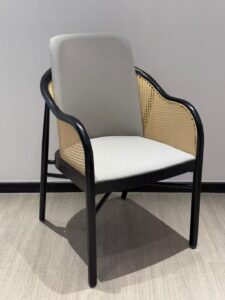
Ⅱ. material traceability: the natural gift of rattan and wood
1.Vine: the resilient spirit of time
The vine, originating from the tropical jungle, is a magical material bestowed by nature. It grows in the wind and rain, taking years or even decades to mature into its ideal texture. The vine’s fibers are both tough and elastic, much like a wise person who has seen much of life yet remains resilient. When harvested by craftsmen, the process involves peeling, soaking, and drying to remove impurities and roughness, leaving behind high-quality materials for weaving.
Its natural and casual texture, with each pattern a testament to the passage of time, carries the scent of the jungle and the touch of sunlight and rain. These patterns are woven into the backrests and armrests of chairs, telling the secrets of nature.
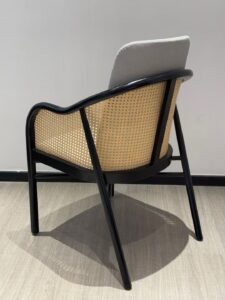
2.Wood: the stable and simple background color of the space
Wood is the timeless classic material for furniture. These chairs are crafted from wood that ranges from deep, stable tones to light, warm shades, each with its own unique character. The wood, sourced from the earth, undergoes processes such as cutting, polishing, and painting, revealing a fine texture and beautiful grain. Its hardness provides the chair with a solid structure, serving as both support and reliance, much like the dependable companions in life. This foundation allows the softness of rattan to take root, and the interplay between rattan and wood, combining strength and suppleness, forms the skeleton and skin of the chair.
Ⅲ. design decoding: ingenuity and temperature in form
1.Shape style: aesthetic expression of multiple integration
(1)Modern minimalist style: the interpretation of subtraction art
This chair can be categorized as part of the modern minimalist style. It eschews intricate decorations, opting for a design with simple lines. The frame features clean lines, free from any unnecessary curves, and the combination of wicker, leather, and fabric is straightforward and elegant. For instance, chairs with black frames paired with light gray or white seats and wicker armrests, which are simple yet stylish.
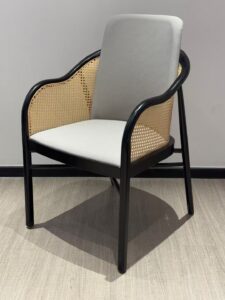
From a functional standpoint, minimalist design meets the demands of modern fast-paced life for space and practicality. The simple appearance allows chairs to seamlessly integrate into various modern decoration settings, whether in a minimalist living room or studio, or in a mixed style space, they can blend harmoniously into the surroundings. The angle of the seat and backrest is carefully considered to be ergonomic, providing comfort and support without the visual or psychological burden that complex designs might impose, embodying the design philosophy of ‘less is more.
(2)Retro industrial style: the interweaving of ruggedness and nostalgia
This black-framed chair, featuring wicker and leather, exudes a retro industrial style. The robust geometric frame, reminiscent of elements from an old factory workshop, adds a cold, industrial feel through its black finish. The addition of wicker and leather softens the harshness, adding a touch of vintage charm. The natural texture of the wicker and the vintage hue of the leather evoke memories of bygone days, as if these chairs have witnessed the hustle and bustle of the industrial era.
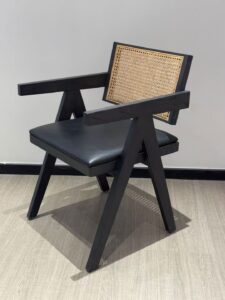
In terms of functional adaptation, these chairs are ideal for loft-style spaces and retro-themed cafes. Their robust structure provides excellent load-bearing capacity, making them suitable for frequent use. The woven rattan and leather surfaces offer a unique tactile experience, allowing users to feel as if they are traveling through time and space, experiencing the blend of industrial retro and modern living. This combination of style and practicality is a wonderful blend.
(3)New Chinese style: the integration of tradition and modernity
This chair embodies the essence of new Chinese style. The wooden frame, paired with a wicker backrest and seat, draws inspiration from traditional Chinese furniture while incorporating modern design elements. The outline of the traditional Chinese armchair is still discernible, but the lines are more refined, avoiding excessive embellishment. The natural texture of the wood and the rustic feel of the wicker convey a deep appreciation for nature, a hallmark of Chinese aesthetics.
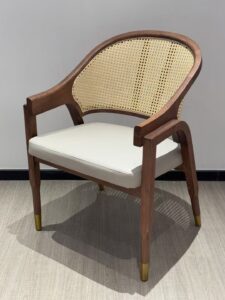
The new Chinese style chair is significant both in its functionality and cultural expression. It not only meets the modern demand for a comfortable seating experience, with its soft cushion and backrest that conforms to the human body’s curves, providing excellent support; it also serves as a cultural symbol, adding an Eastern charm to spaces such as homes and tea rooms. This allows users to feel the influence of traditional culture in their daily use, achieving a modern interpretation of traditional aesthetics.
2.Ergonomics: the wisdom hidden in comfort
The backrest angle, armrest height, and seat depth of each chair are meticulously designed. When we sit down, our backs naturally fit into the chair’s backrest, receiving just the right support, as if a gentle hand is cradling our tiredness. The armrest height allows our arms to rest comfortably, avoiding any discomfort from being left hanging. The seat depth ensures that our thighs can be placed comfortably, promoting smooth blood circulation. These seemingly simple dimensions and angles reflect the designer’s deep understanding of human anatomy, integrating comfort into every detail. This makes the chair not just a piece of furniture but a considerate companion in daily life, quietly supporting our health.
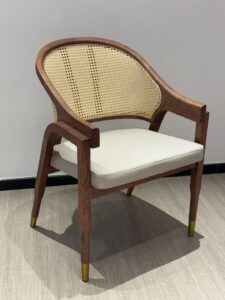
Ⅳ. Fourth, process tracing: the journey of craftsmanship from raw material to finished product
1. The art of wicker: the years between warp and weft
The art of wicker weaving is an ancient and intricate craft. Craftsmen hold wicker strips, weaving them like the warp and weft threads of life, threading them through wooden frames. Each pattern has its own level of difficulty and beauty. Simple plain weave patterns are simple and elegant; intricate designs, like a lively dance, require the craftsman to focus intently, controlling the force and rhythm. Every stitch and every knot embodies the craftsman’s patience and skill, making the wicker part of the chair an artistic embellishment and a medium for conveying the warmth of craftsmanship.
2.The delicacy of woodwork: polishing the texture of time
The treatment of wood is equally important. When cutting wood, precise measurements are essential to avoid any minor errors that could affect the chair’s structure. The sanding process, from coarse to fine sand, gradually smooths the wood surface, making it as smooth as a baby’s skin. Applying paint is a crucial step in enhancing the wood’s beauty and providing protection. The right paint color highlights the wood’s natural grain and forms a protective layer that resists the ravages of time. Each step in the woodworking process is a commitment to quality, transforming raw wood into a sturdy and elegant chair frame.
Ⅴ. Space adaptation: the dialogue between the chair and the home scene
1. Living room: the aesthetic center of social and rest
In the living room, these chairs can be the perfect companions to sofas. Modern minimalist chairs paired with simple sofas can create a stylish and inviting social area. When friends visit, they can gather around, chatting and enjoying the comfort of the chairs, which enhances the conversation. Retro and artistic chairs are ideal for placing in the corner of the living room, complemented by a floor lamp and a small coffee table, turning it into a cozy reading nook for the owner. With sunlight streaming through the windows, sitting on the chair, flipping through magazines, and enjoying a peaceful moment, the chair becomes the soul of this small haven.
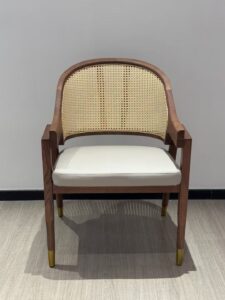
2. Restaurant: texture embellishment in the atmosphere of fire and smoke
The choice of chairs in a restaurant significantly influences the dining atmosphere. The natural texture of wicker and wood chairs can add a touch of relaxation and warmth to the dining area. A simple black wooden frame chair paired with a minimalist dining table is ideal for modern restaurants, where the comfortable feel of wicker and soft upholstery enhances the dining experience. A vintage wooden wicker chair, placed in a family dining room, allows the warmth of wood and the breathability of wicker to break the monotony of daily life, making each meal feel like a cozy home.
3. Study: the quiet company of thought wandering
The study is a haven for the mind, and the role of the chair is crucial. A retro literary style chair, placed beside the desk, with its combination of wood and wicker, creates a tranquil and artistic atmosphere, ideal for immersive reading and writing. As thoughts wander through the pages, the body relaxes in the comfortable chair, and the natural scent of wicker and wood seems to dispel mental fatigue, aiding the flow of inspiration. A modern minimalist chair, if placed in the transitional area between an open study and an office space, can also fit into a simple office environment, allowing for a smooth transition between work and reading.
Ⅵ. cultural symbols: the tradition and modernity of wicker chairs
1. The inheritance of traditional rattan and wood crafts
Wicker furniture has a long history in China, with wicker beds and chairs dating back to ancient times. Wicker weaving is an integral part of traditional craftsmanship. These chairs embody the essence of wicker wood craftsmanship, preserving ancient weaving techniques and wood processing methods, bringing traditional skills to life in modern homes. They serve as cultural carriers, carrying the wisdom of our ancestors, telling stories from the past in contemporary life, and allowing us to experience the warmth and charm of traditional craftsmanship through their use.
2. The injection of modern design language
At the same time, these chairs incorporate modern design elements, featuring simple lines and ergonomic shapes that reflect contemporary design principles. The blend of traditional and modern elements transforms rattan and wood chairs from mere symbols of retro style into practical and aesthetically pleasing furniture that meets the needs of modern life. By innovating while preserving tradition, they serve as a cultural bridge, connecting the past with the present, allowing us to enjoy the conveniences of modern life while also experiencing the essence of traditional culture.
Ⅹ. Emotional connection: the memories of life on the chair
1. The warmth of home
Every chair leaves a unique memory in family life. When children sit on chairs, they babble and learn to stand independently; parents sit on chairs, watching their children grow with satisfaction; the warmth of sharing the day’s events around chairs brings the whole family together. Chairs bear witness to the joys and sorrows of the family, embodying the warmth of home. The moments spent sitting on chairs are precious snippets of life, forming the most vivid emotional memories of’ home.’
2.A solitary spiritual habitat
Besides the warmth of family, a chair serves as a spiritual support during solitary moments. When tired, sitting in a chair allows one to clear their mind and be enveloped by the natural scent of rattan wood, easing stress; when thinking, the chair offers a stable base, helping us sort out our thoughts. On a chair, we engage in a dialogue with ourselves, and those moments of solitude become more meaningful thanks to the chair’s presence. It becomes a physical haven for our souls, quietly safeguarding inner peace.
Ⅷ. The way of maintenance: the secret to keeping your chair company for a long time
1. Woven part: gently care for the natural texture
To prevent fading, drying, and breaking, avoid direct sunlight on wicker. Regularly wipe with a soft cloth to keep it clean. If dust accumulates, gently comb the texture with a small brush. Occasionally wiping with a mild salt water solution can both clean and repel insects, keeping the wicker flexible and lustrous, preserving its natural beauty.
2.Wood part: protect the stable texture
Timber should avoid extreme environments of moisture and dryness. Moisture is prone to mold, while dryness is prone to cracking. Regularly wipe the wooden surface with a clean soft cloth, and use wood maintenance oil appropriately. Apply it along the grain to nourish the wood, so that the wood is always warm and lustrous, and stabilize the skeleton of the chair, so that it can accompany you for a long time.
Ⅶ. wicker chair, the eternal footnote of life aesthetics
This set of rattan and wood chairs, from their materials to designs, from craftsmanship to use, each element conceals the secrets of life’s aesthetics. They are a testament to nature’s gifts and human ingenuity, a dialogue between tradition and modernity, and a vessel for emotions and memories.
In the world of furniture, rattan and wood chairs may not be the most dazzling, but they are certainly the ones that best understand life. May those who share these chairs find beauty in the interwoven textures of rattan and wood, allowing the ordinary to become more poetic and warm through this small object. May these chairs truly become the eternal notes of life’s aesthetics, accompanying us through the years, writing more stories about home and beauty.


